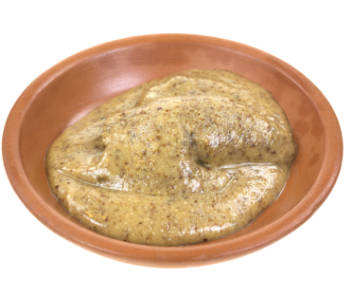Nut & Seed Pastes Category

almond butter
Almond butter is grittier and more expensive than peanut butter, but it can substitute for peanut butter in many recipes.
Learn morealmond paste
This is a paste made with finely ground blanched almonds, sugar, glycerin, and sometimes almond extract. Bakers use it to make cakes and cookies. Bitter almond paste is flavored with oil of bitter almonds, and is worth seeking out if you plan to make amaretti. Look for tubes or cans of it among the baking supplies at your supermarket.
Learn morecandied chestnuts
A French specialty, these are whole chestnuts that are candied in a sugar syrup. They're used to make various desserts.
Learn morecashew butter
This is an interesting alternative to peanut butter, though it's a bit pricey.
Learn morechestnut cream
This is made with puréed chestnuts, brown sugar, and vanilla. It's used as an ingredient in several desserts, including Mont Blanc. Refrigerate after opening.
Learn morechestnut purée
Europeans use this to make everything from soups to stuffings to desserts. You can buy it either sweetened or unsweetened. If you're not sure which one your recipe is calling for, get unsweetened purée and add sugar later if needed.
Learn morehazelnut paste
This is used as a filling in candies and baked goods. Look for it in specialty shops or Middle Eastern markets.
Learn moremarzipan
Marzipan is made from ground almonds and sugar, and it's used to make colorful and edible decorations and confections. Look for tubes or cans of it among the baking supplies in your supermarket.
Learn morenut butter
If you mix roasted nuts, vegetable oil, salt, and maybe some sugar in a blender or food processor for awhile, you'll get a smooth, spreadable paste called nut butter. Nut butters can be spread on bread or crackers, blended into savory sauces, or teamed up with chocolate to make desserts.
Learn morepeanut butter
High in protein and low in cost, peanut butter is a sandwich staple. It's often teamed with jelly, but honey, bananas, onions, and even pickles work well too. Natural peanut butter is made simply of peanuts, oil, and sometimes salt. It's not very popular with consumers, though, since it needs to be refrigerated after opening, and the oil tends to separate and rise to the top. Most shoppers turn instead to commercial peanut butters, which don't need to be refrigerated and don't separate. Unfortunately, these products are made with hydrogenated oils, which are bad for you. Since many people are allergic to peanuts, it's important to alert guests if you're serving something that's made with peanut butter.
Learn morepraline paste
This paste is made with almond or hazelnut butter and sugar, and it's used to make candy and other desserts. It's hard to make yourself, since homemade nut butters tend to be gritty. Unfortunately, it's also hard to find commercially prepared praline paste, though you can order it online at www.kingarthurflour.com. The oil sometimes separates and rises to the top, so stir before using.
Learn moresesame butter
This is a paste made from toasted black (i.e., unhulled) sesame seeds. It's similar to sesame paste, but thicker and darker. Once you've opened it, store it in the refrigerator unless you plan to use it up within a week or so.
Learn moresesame paste
This is a paste made from ordinary white sesame seeds. It's used in the Middle East to make hummus, baba ghanouj, and sauces. The oil tends to rise to the top, so stir before using. Once you've opened it, store it in the refrigerator unless you plan to use it up within a week or so.
Learn more

















































































































































































































































































































































